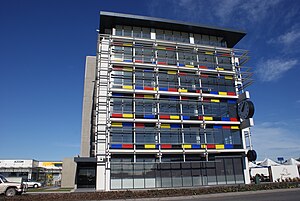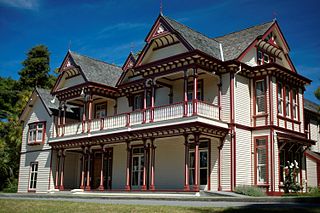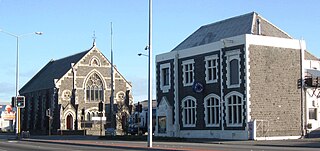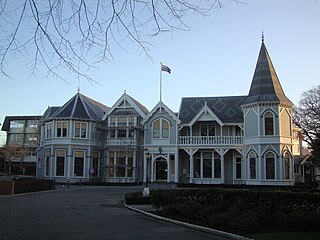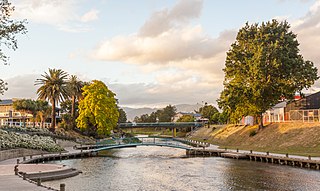History
European settlement
During the early stages of European settlement, Hornby was originally referred to as Southbridge Junction – with the junction acting as the start of the main road south. [4]
Due to rising confusion with the nearby town of Southbridge, a decision was made to rename the area to Hornby in 1878, although the origins of this name are unclear. One explanation holds that the suburb was named after Hornby-with-Farleton in Lancashire by Frederick William Delamain, who came to Christchurch from England in 1852. [5] Delamain owned a nearby homestead, which gave its name to the nearby suburb of Yaldhurst, and was a prominent figure in the area during the latter half of the 19th century. [4] Another version suggests that the name refers to Geoffrey Hornby, who was the Admiral of the British flying squadron and who visited Christchurch in 1870, just prior to the suburb being renamed on 2 September 1878. [6]
Modern history
In 1922, the suburb was chosen by Kempthorne Prosser to be the location for a new super-phosphate plant, used to develop fertiliser. The plant was the company's first in Christchurch and third overall, developed in response to an 1881 incentive from the New Zealand government to facilitate the construction of a local fertiliser industry. [7] This fertiliser plant remains in operation, and is now run by Ravensdown limited, which bought Kempthorne Prosser in 1978. The plant was the location of a large fire in 2018, which prompted nearby evacuations in fear of an explosion and caused thick black smoke to be visible across the region. [8]
Prior to the development of adjacent suburbs such as Wigram, Hornby's isolation from the rest of Christchurch as a result of Wigram Aerodrome and the industrial estates of Sockburn led to it occasionally being considered a town in its own right, however officially it has always been a suburb of Christchurch. Hornby is home to a velodrome and a BMX track. In the past, it has been the location for "Westside Party in the Park", a free Christmas concert. [9]
In April 2024, a new community centre and swimming pool facility opened. It is called the Matatiki Hornby Centre. [10]
Demographics
Hornby comprised four statistical areas in 2018.
Individual statistical areas| Name | Area
(km2) | Population | Density
(per km2) | Households | Median age | Median
income |
|---|
| Hornby Central | 2.27 | 135 | 59 | 45 | 43.4 years | $35,000 [11] |
| Hornby West | 0.74 | 2,493 | 3,369 | 894 | 36.7 years | $32,500 [12] |
| Hornby South | 1.37 | 4,443 | 3,243 | 1,692 | 35.0 years | $31,900 [13] |
| Islington-Hornby Industrial | 7.18 | 342 | 48 | 135 | 50.1 years | $30,800 [14] |
| New Zealand | | | | | 37.4 years | $31,800 |
|---|
Commercial area
The Hornby Central statistical area covers 2.27 km2 (0.88 sq mi) on the north side of Hornby. [2] It had an estimated population of 150 as of June 2023, [3] with a population density of 66 people per km2.
Historical population for Hornby Central| Year | Pop. | ±% p.a. |
|---|
| 2006 | 156 | — |
|---|
| 2013 | 120 | −3.68% |
|---|
| 2018 | 135 | +2.38% |
|---|
| Source: [15] |
Hornby Central had a population of 135 at the 2018 New Zealand census, an increase of 15 people (12.5%) since the 2013 census, and a decrease of 21 people (−13.5%) since the 2006 census. There were 45 households, comprising 75 males and 57 females, giving a sex ratio of 1.32 males per female. The median age was 43.4 years (compared with 37.4 years nationally), with 15 people (11.1%) aged under 15 years, 30 (22.2%) aged 15 to 29, 75 (55.6%) aged 30 to 64, and 12 (8.9%) aged 65 or older.
Ethnicities were 68.9% European/Pākehā, 15.6% Māori, 6.7% Pasifika, 17.8% Asian, and 2.2% other ethnicities. People may identify with more than one ethnicity.
The percentage of people born overseas was 26.7, compared with 27.1% nationally.
Although some people chose not to answer the census's question about religious affiliation, 51.1% had no religion, 33.3% were Christian, 2.2% had Māori religious beliefs and 4.4% had other religions.
Of those at least 15 years old, 12 (10.0%) people had a bachelor's or higher degree, and 24 (20.0%) people had no formal qualifications. The median income was $35,000, compared with $31,800 nationally. 12 people (10.0%) earned over $70,000 compared to 17.2% nationally. The employment status of those at least 15 was that 66 (55.0%) people were employed full-time, 15 (12.5%) were part-time, and 12 (10.0%) were unemployed. [15]
Residential Hornby
The residential areas of Hornby, comprising the statistical areas of Hornby West and Hornby South in 2018, and also Branston in 2023, cover 2.45 km2 (0.95 sq mi). [2] They had an estimated population of 7,850 as of June 2023, with a population density of 3,204 people per km2.
Historical population for residential areas| Year | Pop. | ±% p.a. |
|---|
| 2006 | 6,303 | — |
|---|
| 2013 | 6,612 | +0.69% |
|---|
| 2018 | 6,936 | +0.96% |
|---|
| Source: [16] |
Before the 2023 census, the residential areas had a smaller boundary, covering 2.11 km2 (0.81 sq mi). [2] Using that boundary, the residential areas of Hornby had a population of 6,936 at the 2018 New Zealand census, an increase of 324 people (4.9%) since the 2013 census, and an increase of 633 people (10.0%) since the 2006 census. There were 2,586 households, comprising 3,552 males and 3,387 females, giving a sex ratio of 1.05 males per female, with 1,191 people (17.2%) aged under 15 years, 1,608 (23.2%) aged 15 to 29, 3,114 (44.9%) aged 30 to 64, and 1,023 (14.7%) aged 65 or older.
Ethnicities were 69.1% European/Pākehā, 12.9% Māori, 6.0% Pasifika, 20.8% Asian, and 2.6% other ethnicities. People may identify with more than one ethnicity.
The percentage of people born overseas was 26.6, compared with 27.1% nationally.
Although some people chose not to answer the census's question about religious affiliation, 49.0% had no religion, 36.7% were Christian, 0.7% had Māori religious beliefs, 2.6% were Hindu, 1.0% were Muslim, 1.1% were Buddhist and 2.1% had other religions.
Of those at least 15 years old, 711 (12.4%) people had a bachelor's or higher degree, and 1,419 (24.7%) people had no formal qualifications. 465 people (8.1%) earned over $70,000 compared to 17.2% nationally. The employment status of those at least 15 was that 3,117 (54.3%) people were employed full-time, 684 (11.9%) were part-time, and 219 (3.8%) were unemployed. [16]
Islington-Hornby Industrial area
The Islington-Hornby Industrial area covers 7.27 km2 (2.81 sq mi) to the south of Hornby. [2] It had an estimated population of 340 as of June 2023, [3] with a population density of 47 people per km2.
Historical population for Islington-Hornby Industrial| Year | Pop. | ±% p.a. |
|---|
| 2006 | 417 | — |
|---|
| 2013 | 381 | −1.28% |
|---|
| 2018 | 342 | −2.14% |
|---|
| Source: [17] |
Before the 2023 census, the industrial area had a smaller boundary, covering 7.18 km2 (2.77 sq mi). [2] Using that boundary, Islington-Hornby Industrial had a population of 342 at the 2018 New Zealand census, a decrease of 39 people (−10.2%) since the 2013 census, and a decrease of 75 people (−18.0%) since the 2006 census. There were 135 households, comprising 189 males and 153 females, giving a sex ratio of 1.24 males per female. The median age was 50.1 years (compared with 37.4 years nationally), with 30 people (8.8%) aged under 15 years, 60 (17.5%) aged 15 to 29, 192 (56.1%) aged 30 to 64, and 60 (17.5%) aged 65 or older.
Ethnicities were 79.8% European/Pākehā, 11.4% Māori, 7.9% Pasifika, 7.9% Asian, and 0.9% other ethnicities. People may identify with more than one ethnicity.
The percentage of people born overseas was 16.7, compared with 27.1% nationally.
Although some people chose not to answer the census's question about religious affiliation, 58.8% had no religion, 32.5% were Christian, 0.9% had Māori religious beliefs, 0.9% were Muslim, 0.9% were Buddhist and 0.9% had other religions.
Of those at least 15 years old, 21 (6.7%) people had a bachelor's or higher degree, and 102 (32.7%) people had no formal qualifications. The median income was $30,800, compared with $31,800 nationally. 30 people (9.6%) earned over $70,000 compared to 17.2% nationally. The employment status of those at least 15 was that 171 (54.8%) people were employed full-time, 33 (10.6%) were part-time, and 9 (2.9%) were unemployed. [17]
